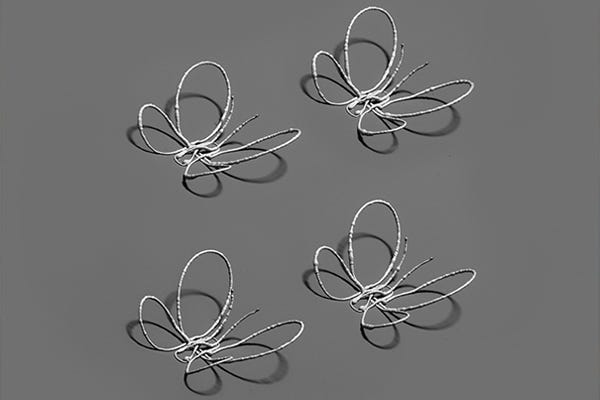May 23, 2016
Harvard University researchers created a novel method for 3-D printing complex metallic architectures using a programmed laser to solidify ink composed of silver nanoparticles. The method could enable more medical device advances.
Kristopher Sturgis
|
These 3-D printed wire butterflies were produced using new printing technique. (Image courtesy of Lewis Lab/Wyss Institute at Harvard University) |
When it comes to wearable technologies, many advancements are held back by the complications of creating structures from rigid, inflexible materials. The increase in demand for innovative wearable technologies was what inspired researchers from Harvard University to devise a unique 3-D printing method that can produce flexible metal electrodes and complex structures in real time.
Jennifer Lewis, professor of biologically inspired engineering at the Harvard School of Engineering and Applied Sciences and leader of the study, says that this new method is much more suited for the production of electronic sensors and coils than traditional printing methods.
"The traditional method of 3-D printing metal is a process known as selective laser sintering, where a bed of metal powder is melted by a scanning laser in a layer-by-layer process," she says. "While this process is useful for producing large, bulky components like a wrench or engine part, it is not well suited to producing delicate wire structures for electronics, such as sensors, antennae, or coils. Instead, with laser-assisted direct ink writing, we can write these delicate structures in a single step, within seconds, without relying on a step-by-step, layer-by-layer process."
Lewis and her team devised a method that uses ink made from silver nanoparticles. The ink is sent through a printing nozzle before a laser precisely applies the right amount of energy to anneal the ink and solidify it. The nozzle is programmed to move along x, y, and z axes to provide the ability of freeform curvature. The result is a 3-D printing technique that can create metallic hemispherical shapes, spiral architectures, and other freeform designs--all of which can be crafted with accuracy down to the width of a hair in a matter of seconds.
"Normally, we can't produce curvy structures in mid-air since the material is too soft to hold its shape," Lewis said. "Here, we have devised a silver nanoparticle ink that has a toothpaste-like consistency that can be squeezed out through a nozzle to generate microscopic, conductive silver wires. We co-align an infrared laser to rapidly heat the silver ink as it exits the nozzle, effectively solidifying it in place. This is how we can draw complex structures in three dimensions without support material."
The market for 3-D printing technologies is one that continues to expand with each passing year. Just last week Johnson & Johnson announced a partnership with HP that will see the two industry giants collaborate on developing medical products from 3-D printing technologies. The two companies plan to focus on the personalization of instrumentation and software related to medical devices, signaling a bright future for 3-D printing technologies in the realm of medtech.
Stryker is meanwhile spending $400 million to build a 3-D printing plant in Ireland, and Smith & Nephew recently turned to 3-D printingto promote in-growth for one of its newest titanium hip implant cups.
It's this kind of demand that drives research and innovation--much like the work that Lewis and her team have invested in. The team's new technique could serve as the basis for more programmable 3-D printed devices in an industry where precision is paramount. Lewis even noted that as they move forward with their research, this process could eventually be turned into a simple-to-use technique for anyone.
"We believe that this technology has great potential," she says. "Many implantable and wearable electronic devices require complex, customized, flexible, patient-specific geometries. Laser-assisted direct ink writing allows for programmable conductive architectures that can be written directly onto and above flexible plastic substrates, which we believe will be of interest to the medical devices industry. With further engineering and industrial development, such as incorporating automated alignment procedures, we believe that this process can be turned into a more user friendly, off-the-shelf system as well."
Learn more about cutting-edge medical devices at MD&M East, June 14-15, 2016 in New York City. |
Kristopher Sturgis is a contributor to Qmed.
Like what you're reading? Subscribe to our daily e-newsletter.
About the Author(s)
You May Also Like



